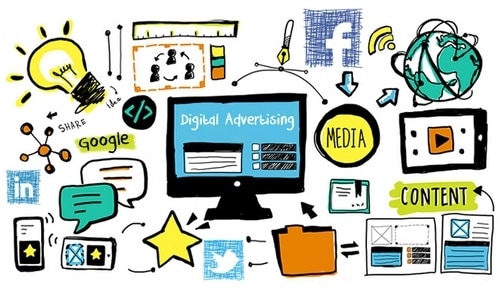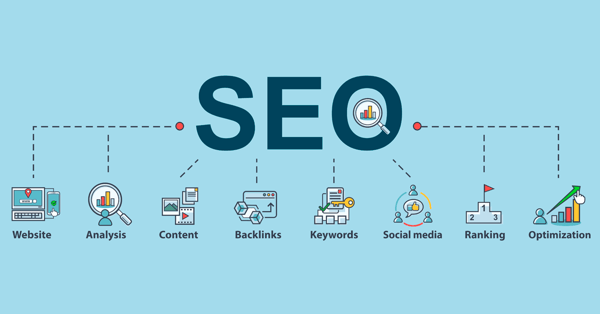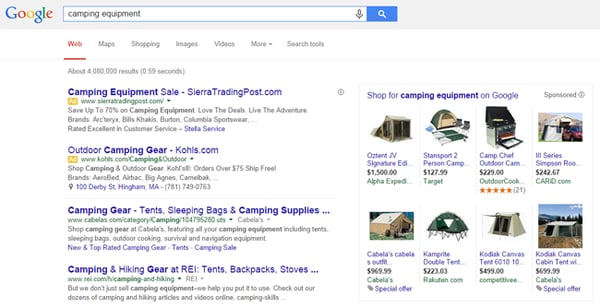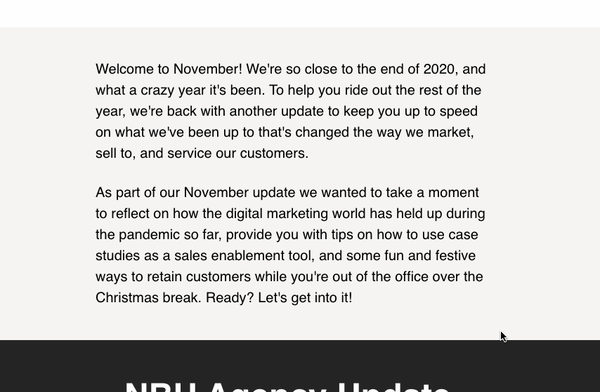There is no denying that the pandemic has accelerated the growth of e-commerce in 2020. While countries around the world locked down, the digital world took off, as people turned to trusty ol’ Google, to learn how to make their favourite restaurant-style meals, how they can revamp their wardrobe to order (because boy … does it need a freshen up!), and even how they might jazz-up a Zoom call for Friday quaran-tinis with the girls.
With 62% of customers buying more online than ever before, businesses are recognising the importance of taking their advertising strategies, online. But, it’s not as easy as setting up a site and waiting for the customers to come flooding in. Far less “Field of Dreams” than we’d perhaps prefer, the increased number of people on the web, means that to get noticed; you’ve got your work cut out for you!
In the advertising world, there’s a lot going on. So rather than channeling your inner ‘Kanye West Twitter-sesh’, let’s keep our cool, and start by looking at what advertising actually is.

Simply put, advertising is the art of persuasion; more importantly, persuading current or potential customers to form a favourable view of your product or service. But with a range of advertising strategies out there, how are you supposed to know which one is the right one for your business? And perhaps most importantly, how can you sell effectively without coming across like those “middle-of-the-shopping-centre-sales-reps” that want GOLD 4 CASH, or make you feel like a shoddy human being because you don’t have time to stop to check out their “world-class” waffle-makers.
To help you figure out what strategy is right for your business, here’s a list of online advertising strategies that actually work (and won’t force an entire generation to practice taking imaginary phone calls to avoid you mid-aisle … just me?), that you can start implementing right now!
A well-designed website
It may seem like this is as obvious as the concept of finding Wally, but sometimes, you just can’t find him, no matter how hard you look. Like our stripey-pal, even though a well-designed website is universally so important, it can often be overlooked. But why is it SO important? More than half of all customers say that they are less likely to engage if the website is poorly designed. You need a website that’s designed well, is simple to use, and has all the necessary information your customers or business associates would need. We live in the digital age (blue pill, red pill and all that), so it’s important you aren’t still stuck with a slow, unresponsive, poorly designed website that isn’t even suited for mobile phone viewing.
Think of a website like an in store shop. It's the entry point to your store, and should be easy to find and attractive enough for customers to want to enter. Once they do, the layout should be easy to understand and there shouldn’t be too much clutter so that whatever you are selling, can be found easily.
Secondly you need to set up landing pages, as these are the starting point for your relationship with your target market - kind of like the virtual customer service assistant you'd find in store. They need to communicate who you are, what you do, what your offerings are, and how customers can buy or subscribe. This page shouldn’t be crowded with unnecessary information, no matter how important you believe it to be.
Don’t get me wrong, as much *fun* as it can be spending a few hours searching for the secret alleyway bars you’ve seen on social media… this is not what you want for your potential customers when designing your website and landing pages. The end goal is that your website needs to answer the problem you are trying to solve. Frame the question from the target market's point of view and then let your landing page do the talking (or rather ... the answering!)
Search Engine Optimisation (SEO)
Once you have a website set up and ready to go, it’s time to make sure that your customers can find you. As 93% of all users begin by searching online, a key element to your online advertising campaign should be to get featured high on those SERP’s (search engine results pages). It’s a competitive digital space out there, and with 70% of users limiting their engagement to the first five search results, you have to be ranking close to the top to get noticed by potential customers (and to get traffic to your site). It all begins with Search Engine Optimisation, or more importantly, with an understanding of the keywords your customers or prospective customers are using.
Put it this way. If your landing pages are offering an answer, what’s the question? What are your customers searching for in the first place? SEO begins with gathering those keywords and incorporating them into your website, in a manner that makes sense. The next important step is to offer relevant content on your site that matches the questions and the language that your customers are using in their searches. Think about it this way: An unknown prospect online has asked a question that your product or service could help with; it’s your website’s job to answer their questions through your SEO efforts. If you’re a business that sells clothes, your content shouldn’t be around developing the same content that a bank does. You also wouldn’t use keywords such as ‘kids clothing’, if you only sold menswear. Keep it to your industry, and to what it is that is actually relevant to your offering.

But that’s only a part of the SEO investment you will have to make. The next important step is to offer relevant content on your site that matches the query and the language that your customers are using. To help you figure this out, put yourself in the shoes of your buyer persona, or the key consumer you are targeting. If they were to turn to Google to ask a question that your product or service could help them with, you’d want to make sure your website answers that question. This can be achieved through rigorous SEO.
SEO can be a long, tedious and continuous process, but the benefits really do outweigh the costs for your online marketing efforts. There are tools out there to help you, and here at Neighbourhood, we’ve been utilising SEO software Frase to help with our own SEO efforts. FRASE is software that helps you to research, create, and optimise your content to help you rank in search engines. It does so by showing you what to tweak or take action on to improve your content and SEO, so the hard work is (almost) done for you.
Pay-per-Click (PPC)
The objective of any digital marketing or advertising strategy is to get more people to visit your website and buy the products or service you are selling. SEO is an extremely effective yet tedious way to do that, which can seem frustrating especially when first starting out. Another strategy that can work in combination with your SEO efforts, is Pay-per-Click (or PPC), which allows you to create ads on the results page of search engines that match the keywords you’ve already outlined from your SEO planning. In fact, more than 40% of all clicks on the results page are for any of the three paid ads at the top.

SEO is a long-term game that requires constant attention to ensure your website is constantly optimised for relevant keywords. SEO is more of an organic way to build your presence and credibility, whereas PPC allows you to pay your way for visibility. You place bids on the keywords that you select and if your bid is higher than your competitors’, you will be placed above the actual search results. The best part about PPC is that you only pay if someone clicks on your ad. More importantly, if you’ve done your research properly, those who actually do click on your ad are also likely to be interested in what you are offering. Bonza!
Social media
As we continue to discover distant - (sometimes not distant enough) - relatives online, it shouldn’t surprise you that a staggering 3.48 billion human beings are on social media. To put it in context, that’s more than half of the total world population. Sure, while it might just be a breeding ground for cat videos, tik toks, memes and celebrity workout photos at the best of times, the advertising opportunities are endless. Studies have found out that about 75% of all customers look at social media before they buy anything online, which makes social media a channel you can no longer afford to ignore.
No matter what your product or service is, you may have to be present on almost all social media platforms. But you will have to focus on those where your target audience is likely to hang around. Once you decide that core set of platforms, whether it’s YouTube and Instagram or Twitter and Facebook, you will have to start creating and curating content that your audience will be interested in. A word of caution; it shouldn’t be just about selling. It should be about being interesting in the world your product lives in. Try developing advertising campaigns or a series; it will work wonders for your target market as you can serve them up regular content you know they'll get value from.
You can also advertise on the selected platforms. An advantage of social media advertising is that you will be able to carefully target the audience based on several factors. And you will be able to learn and change your content accordingly.
Email Marketing
Ever signed up for an email marketing list with the promise of getting 10% off your first purchase, and then started getting inundated with marketing content you don’t care about? While you may have experienced email marketing in the form of spam, when executed correctly, email marketing can actually give you really great results. In fact, email marketing has the potential to perform so well that more than 80% of all marketers say they use email marketing for generating leads.
To get it right, think of email marketing as a conversation you are having with your audience, one-on-one. You should offer something that adds value to their lives and goes way beyond just selling something. The idea is to be interesting, and engaging and not just end up sitting in their mailbox unread. Everything from your subject line, to the message should be developed like a friend offering help or effective tips. A way we do this at Neighbourhood is by breaking up content into digestible blocks separated with images and gifs and links - to keep it easy to read and engaging!

At the end of the day, there's one thing for certain; the e-commerce train, is going full speed ahead with no signs of slowing down - so hop aboard, don't merely let it pass you by! A successful online marketing strategy will have a mix of these advertising strategies in the marketing mix, to h. For effective advertising, it’s important to see your work for each one of these components as an investment in your business. If you do them all together, with necessary attention and customisation, you'll be first in line to see the results.



